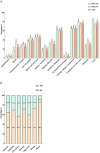Prevalence of depressive symptoms and correlates among individuals who self-reported SARS-CoV-2 infection after optimizing the COVID-19 response in China
- PMID: 38259743
- PMCID: PMC10800514
- DOI: 10.3389/fpubh.2023.1268799
Prevalence of depressive symptoms and correlates among individuals who self-reported SARS-CoV-2 infection after optimizing the COVID-19 response in China
Abstract
Background: The burden of depression symptoms has increased among individuals infected with SARS-CoV-2 during COVID-19 pandemic. However, the prevalence and associated factors of depressive symptoms among individuals infected with SARS-CoV-2 remain uncertain after optimizing the COVID-19 response in China.
Methods: An online cross-sectional survey was conducted among the public from January 6 to 30, 2023, using a convenience sampling method. Sociodemographic and COVID-19 pandemic-related factors were collected. The depression symptoms were assessed using the Patient Health Questionnaire-9 (PHQ-9). Logistic regression analysis was performed to explore the associated factors with depressive symptoms.
Results: A total of 2,726 participants completed the survey. The prevalence of depression symptoms was 35.3%. About 58% of the participants reported experiencing insufficient drug supply. More than 40% of participants reported that they had missed healthcare appointments or delayed treatment. One-third of participants responded experiencing a shortage of healthcare staff and a long waiting time during medical treatment. Logistic regression analysis revealed several factors that were associated with depression symptoms, including sleep difficulties (OR, 2.84; 95% CI, 2.34-3.44), chronic diseases (OR, 2.15; 95% CI, 1.64-2.82), inpatient treatment for COVID-19 (OR, 3.24; 95% CI, 2.19-4.77), with COVID-19 symptoms more than 13 days (OR, 1.30, 95% CI 1.04-1.63), re-infection with SARS-CoV-2 (OR, 1.52; 95% CI, 1.07-2.15), and the increased in demand for healthcare services (OR, 1.32; 95% CI, 1.08-1.61).
Conclusion: This study reveals a moderate prevalence of depression symptoms among individuals infected with SARS-CoV-2. The findings underscore the importance of continued focus on depressive symptoms among vulnerable individuals, including those with sleeping difficulties, chronic diseases, and inpatient treatment for COVID-19. It is necessary to provide mental health services and psychological interventions for these vulnerable groups during the COVID-19 epidemic.
Keywords: COVID-19; PHQ-9 scale; depressive symptoms; healthcare services; optimizing the COVID-19 response.
Copyright © 2024 Wei, Qin, Lin, Huang, He, Yu, Zhang, Li, Cen, Li, Luo, Zhang, Zhong, Qin, Li, Yang, Pan, Zhao, Wu, Jiang, Liang, Ye and Liang.
Conflict of interest statement
The authors declare that the research was conducted in the absence of any commercial or financial relationships that could be construed as a potential conflict of interest.
Figures



Similar articles
-
Prevalence of and Risk Factors Associated With Mental Health Symptoms Among the General Population in China During the Coronavirus Disease 2019 Pandemic.JAMA Netw Open. 2020 Jul 1;3(7):e2014053. doi: 10.1001/jamanetworkopen.2020.14053. JAMA Netw Open. 2020. PMID: 32609353 Free PMC article.
-
Prevalence and associated factors of depressive and anxiety symptoms among healthcare workers in the post-pandemic era of COVID-19 at a tertiary hospital in Shenzhen, China: A cross-sectional study.Front Public Health. 2023 Mar 20;11:1094776. doi: 10.3389/fpubh.2023.1094776. eCollection 2023. Front Public Health. 2023. PMID: 37020820 Free PMC article.
-
The correlation between lifestyle health behaviors, coping style, and mental health during the COVID-19 pandemic among college students: Two rounds of a web-based study.Front Public Health. 2023 Jan 12;10:1031560. doi: 10.3389/fpubh.2022.1031560. eCollection 2022. Front Public Health. 2023. PMID: 36711327 Free PMC article.
-
A systematic review and meta-analysis on prevalence of and risk factors associated with depression, anxiety and insomnia in infectious diseases, including COVID-19: a call to action.Mol Psychiatry. 2022 Aug;27(8):3214-3222. doi: 10.1038/s41380-022-01638-z. Epub 2022 Jun 6. Mol Psychiatry. 2022. PMID: 35668158 Free PMC article.
-
Prevalence of depressive and anxiety symptoms among Chinese older adults during the COVID-19 pandemic: A systematic review and meta-analysis.J Geriatr Psychiatry Neurol. 2022 Mar;35(2):182-195. doi: 10.1177/08919887221078556. J Geriatr Psychiatry Neurol. 2022. PMID: 35245999 Free PMC article.
References
-
- Benke C, Autenrieth LK, Asselmann E, Pane-Farre CA. Stay-at-home orders due to the COVID-19 pandemic are associated with elevated depression and anxiety in younger, but not older adults: results from a nationwide community sample of adults from Germany. Psychol Med. (2020) 2:1–2. 10.1017/S0033291720003438 - DOI - PMC - PubMed
Publication types
MeSH terms
LinkOut - more resources
Full Text Sources
Medical
Miscellaneous

